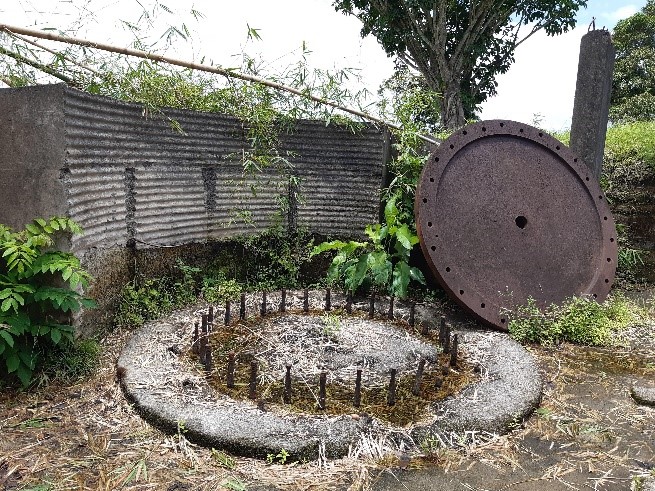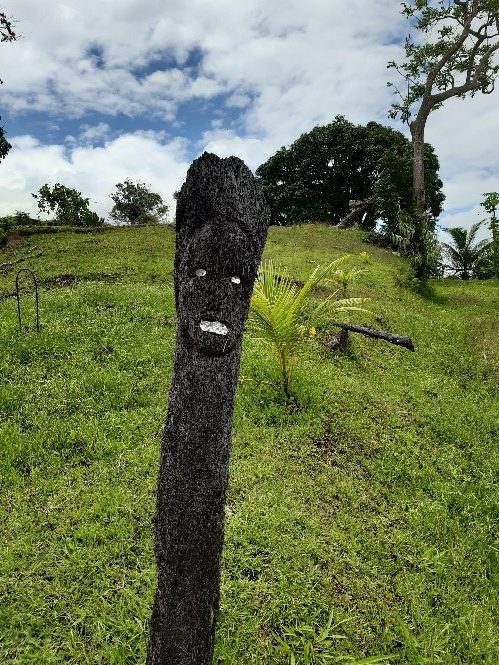-
Out and About (Guest blog by Karin Taylor, 22 January 2020)
Posted on January 22, 2020A guest blog by Karin Taylor, Head of Planning at the National Trust for England, Wales and Northern Ireland
Fiji Diary – Out and about
This week has been a busy one, getting out and about to see the local heritage both in and around the city. This is one of the things I love about both being a planner and working for a National Trust – never being stuck at a desk for too long! Fortunately, with Cyclone Tino having now headed way down into the Pacific the weather was kind.
First on the agenda was a trip out with Jone and Josefa to see two local archaeological sites, one ancient and one more recent.
 Gun batteries
Gun batteriesDuring the Second World War a number of gun batteries were built to protect the strategically important bays at Suva in the south east of Viti Levu and at Momi Bay, south of Nadi in the west of the island. We went to see the remains of the Bilo gun battery on a headland west of Suva, which had been under the care of the Fiji Museum but is now looked after by members of the local community. Whilst most of the metalwork has been removed, and the site is suffering from lack of maintenance, it is an important part of local history although the guns were never used in anger – the Japanese did not get this far. The site attracts a small but steady trickle of visitors, including passengers from the cruise ships calling at Suva, and raises some interesting issues in terms of visitor welcome and accessibility. The income is small, but no doubt important to the family who act as custodians, but there is effectively no money for maintenance. In common with WW2 sites and similar concrete structures closer to home, the physical remains are deteriorating, and repair or conservation is very difficult. Added to this are security issues and preventing misuse.

The local Custodian, Sitiveni
Land and community
In Fiji the relationships between land and local communities are very important. For the indigenous Fijians in Fiji (the iTaukei) land is generally seen as an ancestral trust which the present generation have to pass over to future generations. Similarly, they maintain a very strong cultural link with land which is their most valuable heritage.
From the Bilo Gun Battery we drove back through the city to the eastern outskirts and to a very different, and much older site. This was an ancient village site (the village having long gone) within a defensive ring ditch.
The National Trust for Fiji owns this unique site but is currently handing over the management of it to a local family who are forming a community group. This is the first such initiative for NTF within an urban area. Apart from its historic and cultural interest the site is also planted with indigenous tree species and fruit trees and has considerable potential for education and as an attraction for visitors and tourists.

Colo I Suva Forest Park
The third visit was to the Colo I Suva Forest Park to the north of Suva, a protected forest area previously planted with mahogany and now managed for wildlife and recreation by the Ministry of Forestry. The land slopes steeply into densely vegetated valleys, with stunning waterfalls and pools. I would love to go back there and it’s only 10 minutes from where I live, but I’ve been advised on no account to go on my own due to the risk of thefts and muggings. There were few other visitors there when we went – another underused asset.

Lots to learn …
These visits have given me a much better understanding of the challenges of managing both natural and historic/cultural sites in Fiji. There is however still a lot for me to get to grips with, especially in relation to the deep relationship between people and land and the implications for NTF in terms of how to navigate and influence the associated relationships. Whilst this featured in the first half of my week, in the second half my attention was turned to the historic environment of the city centre – and there’s more than enough material there for another instalment!

 44 (0)20 7824 7157
44 (0)20 7824 7157